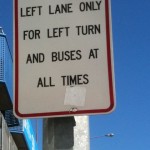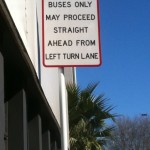BusLane Debate Is Global
 Don’t be fooled into thinking Auckland City’s bus lane enforcement is something peculiar to this city.
Don’t be fooled into thinking Auckland City’s bus lane enforcement is something peculiar to this city.
The campaign over issues related to motorists using Auckland bus lanes smells of a manufactured local body election setup but really is symptomatic of a cry being raised by motorists everywhere.
The ongoing fining of motorists who use Grafton Bridge during bus-only periods should have warned us that motorists hate bus lanes and will do anything to get them removed.
And newspapers love to tap into their anger as a way to sell newspapers and create conflict between motorists and local authorities as conflict makes news.
Let’s a quick look at what is going on this week around the world about motorists and newspapers vs bus lanes. It will sound familiar.
Bus lanes like New York’s 1.9-mile S.I.E. route are being loudly publicly attacked for what has become termed the “empty lane syndrome,” where gridlocked drivers seethe next to lanes that move a bus every minute or so during rush hour.
Even John Banks made a comment recently complaining he couldn’t get onto Remuera Rd for ages but could have if he was allowed to use the bus lane not being used at the time.
And campaigns to get rid of bus lanes themselves are happening all over the place as politicians see a way to attract votes from motorists sick of the empty bus lane syndrome.
In the city of Knox, 25km east of Melbourne, the local paper has been waging an Royal NZ Herald-type campaign against bus lanes saying it “has been inundated with letters from irate motorists demanding the bus lane be scrapped, as they say it is dangerous and causes traffic jams.”
This led to a knee-jerk reaction from councillors who moved to scrap the unpopular lane and rule out supporting future ones that cost motorists’ vehicle lanes but the move failed. But a campaigning Liberal Party MP vows to scrap it and stop plans for more because of the “chaos” it causes motorists.
And in Worchester in the UK, the local paper there applauds a Tory MP who vows to kill off a bus lane.
 In a very Royal NZ Herald-type editorial, the paper says: “It seems Mr Walker’s intervention at government level, added to some substantial public opposition, has put the final nail in the coffin of the Bromyard Road bus lane scheme. In this period of public sector austerity, we agree with Mr Walker that the millions earmarked for the scheme could be better spent elsewhere.”
In a very Royal NZ Herald-type editorial, the paper says: “It seems Mr Walker’s intervention at government level, added to some substantial public opposition, has put the final nail in the coffin of the Bromyard Road bus lane scheme. In this period of public sector austerity, we agree with Mr Walker that the millions earmarked for the scheme could be better spent elsewhere.”
Residents had complained they would have not been able to park in the main street.
In Bristol, the paper carries another NZH-type enraged comment calling the city council out of touch with plans to create a parking levy to pay for public transport.
“People should not be forced to leave their cars at home, but be encouraged to do so. Instead of 24-hour bus lanes it would surely be better to open them up after rush hour to get cars moving freely during the rest of the day.After all, apart from banning cars altogether, isn’t this the way to reduce pollution? It seems ridiculous to have cars stuck in jams when a bus lane is empty for most of the day.”
In New York, the paint had not even dried on new bus lanes along the eastern end of the Staten Island Expressway before politicians began to pressure the NY State transport department to open them to car traffic.
Authorities are now thinking about a slow gradual 3 year move to bus only lanes there and allowing cars with three people to use them.
There still isn’t enough enforcement on that stretch with only talk of cameras being used.
But in New York, taxi drivers are complaining this week. If they are caught on video driving in the bus lane they are now getting a $250 ticket. The Taxi and Limousine Commission sent out 30 tickets so far and another 120 tickets are on the way.
The stated goal is to speed up New York city buses which are some of the slowest buses in the US.
Indonesia’s capital is finally getting serious about its long established bus lanes.
After years of lip service, the city administration will clear motorists from the bus lanes. From this week, the council is deploying 468 officers from several institutions to ensure no motorists use the special bus lanes. The lanes were set up years ago to encourage people to use public transport but in reality, almost all motorists encroach on the lanes, sometimes risking their lives and the lives of bus passengers.
The administration’s attempt to deal with the issue by banning vehicles from entering the lanes failed until now as other lanes were already congested, leaving the authorities thinking they had no option but to allow motorists to use the busway lanes during rush hour.
There were 270 car /bus accidents in the lanes last year.
Sensible councils are ignoring the anti-bus lane brigade, explaining why and publicly promoting public transport above all else.
In Perth, on busy commuter routes, there are two kerbside bus lanes, but the transport authority wants to see if permanent 24-hour bus lanes could be added to these, or possibly replace them.
The Scottish government wants local authorities to have greater power to punish those who use the lanes in order to beat traffic, blocking public transport. Under current rules, only local police have the power to catch cheating drivers, but the consultation will help to give councils more authority to fine anyone taking their car into a bus lane.
Scot’s transport minister says his government is committed to improving public transport to help more people make the switch from private car to more sustainable, greener modes of transport.
How is this for madness: In Aberdeen, hundreds of motorists have escaped prosecution in recent times because the police force which has to hand out the fines, said they would not pay the $78,000 for an IT upgrade to allow images from bus-lane cameras to be processed.
And in a familiar cry we hear in Auckland from roading enthusiasts, the Scottish Institute of Advanced Motorists said: “These cameras will prove easy pickings for councils struggling to make ends meet.“This has absolutely nothing to do with safety or traffic flow, it’s just another tax on motorists. It would be crazy to place bus lane enforcement in their hands and I don’t think motorists will stand for it.”
In the US in Jacksonville, the transportation authority is taking away parking on four downtown streets to make room for buses saying creating the bus only lanes is the first step towards “rapid transit” making bus trips speedier and more direct.
In the UK, in Essex county, there is a $13m project to put in bus lanes at peak times (used by buses, motorbikes and cyclists), bus priority lights, better bus stops and real time info displays to encourage motorists to use buses instead. But one planned bus lane was scrapped because of a public outcry over trees having to be chopped to create it!
In India, ‘spy’ cameras are being installed in a 14k stretch of bus rapid transit bus only lanes to photograph offending motorists.
While in Geneva, authorities are trialling super cameras that can detect up to 10 kinds of traffic crimes and misdemeanours—tailgating, jumping red lights or stop signs, drifting into cycle or bus lanes, overtaking dangerously and of course speeding. They take speed detection to a new level too—they can follow the path of 22 vehicles at once and across four lanes, not just the standard two.
And it will interesting to see if Wellington motorists rant Auckland-style - or its anti-rail pro-motorist local media does -about new bus lane enforcement.
RNZ reports six cameras are to be set up along bus lanes in Wellington to catch motorists breaking the law.
Motorists can be fined $150 for driving more than 50 metres in a bus lane.
And an interesting cycle lane carry on protest at the moment in Melbourne.
In June, Melbourne City Council opened new-style bike lanes along a busy arterial, which carries 25,000 cars a day in and out of the central business district. But since the installation, several groups have said the lanes are dangerous and confusing. The council has reported one accident on the street involving a cyclist since the lanes were installed.
During morning and afternoon peak hours, the street has two lanes of traffic on each side and no parked cars. Outside these times, the lanes of traffic nearest the kerbs turn into parking spaces, creating lines of parked cars that act as buffers for the bicycle lanes.











0 Comments
You can be the first one to leave a comment.